Commercial names
Twin Win, Up&Up
Caracteristics:
Full replication of upward and downward movements of the underlying asset’s price at maturity
Barrier for conditional capital protection
Full, more than proportional replication of upward movements of the underlying asset’s price
Return profiles
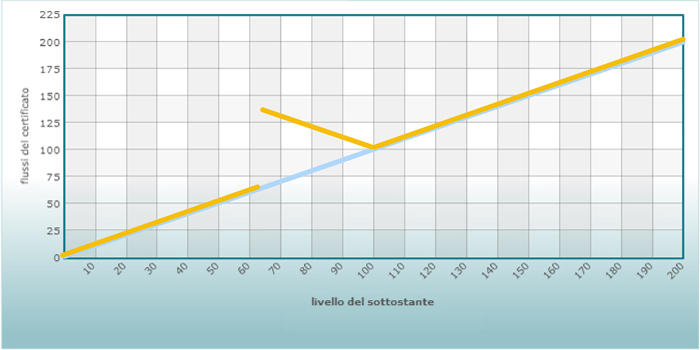
| Maturity | 3 - 5 years |
| Investment horizon | Mid / long term |
| Aim | To profit from both upward and small downward movements of the underlying asset’s price |
| Strategy | Bi-directional (at issue), if the underlying asset’s price does not reach the barrier during the life of the certificate Bullish, if the underlying asset’s price exceeds the barrier level during the life of the certificate |
| Capital protection at maturity/Risk | Capital protection at maturity up to a set level. Partial replication of downward movements of the underlying asset’s price in case the underlying asset’s price has been lower than or equal to the barrier level during the life of the certificate |
Learn more
Investment certificates are financial products characterized by a number of features. They may simply replicate the underlying asset’s upward movements or downward movements, or they may be structured so as to implement more sophisticated strategies, which may include total or conditional capital protection against bad performances of the underlying asset (protection component).
Some certificates’ characteristics may also allow the owners to obtain proceeds during the life of the certificate, under condition that specific events take place (income component). A premium may be paid at maturity under form of additional proceeds in case the underlying asset’s price does not drop under the barrier (this is the case, for example, of bonus certificates).
The return on investment in some typologies of certificates may be determined by both the changes in the underlying asset’s price and the absence of such price movements for a timespan shorter than the life of the contract (early reimbursement component). These certificates pay a sort of premium for early redemption in case the underlying asset’s price is above a certain level on pre-arranged dates.
Moreover, some certificates feature an additional element, useful in periods of strong fluctuations of exchange rates – a protection against unfavourable changes in currency value. Products offering such protection, called “Quantum”, make it possible to invest in underlying asset’s denominated in a foreign currency avoiding exposure to the risks linked to exchange rates.
Features
The certificates’ payoff characteristics imply the following components: protection component, participation to upward movements in the underlying asset’s price, participation to downward movements in the underlying asset’s price.
Performance drivers
Reactivity of the certificates’ prices to changes in key variables.
| Variables | Issue | Barrier** | Life residual*** |
Autocallable
Commercial names
Autocallable Twin Win
Caracteristics:
Full replication of upward and downward movements of the underlying asset’s price at maturity
Early redemption in case the underlying asset’s price is higher than or equal to a set level on pre-arranged observation dates
Barrier for conditional capital protection
Full, more than proportional replication of upward movements of the underlying asset’s price
Return profiles
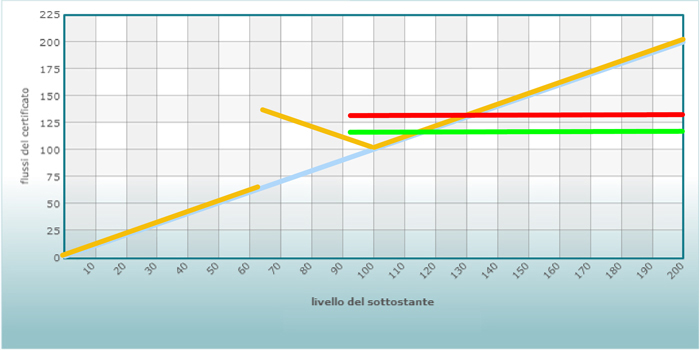
| Maturity | 3 - 5 years |
| Investment horizon | Mid /long term |
| Aim | To profit from both upward and small downward movements of the underlying asset’s price To obtain quickly early redemption and premium |
| Strategia | Moderately bullish (from the date of issue to the last available date for early redemption) Bi-directional (at maturity) |
| Capital protection at maturity/Risk | Capital protection at maturity up to a set level. Full replication of downward movements of the underlying asset’s price if the underlying asset’s price is lower than a pre-arranged level at maturity |
Learn more
Investment certificates are financial products characterized by a number of features. They may simply replicate the underlying asset’s upward movements or downward movements, or they may be structured so as to implement more sophisticated strategies, which may include total or conditional capital protection against bad performances of the underlying asset (protection component).
Some certificates’ characteristics may also allow the owners to obtain proceeds during the life of the certificate, under condition that specific events take place (income component). A premium may be paid at maturity under form of additional proceeds in case the underlying asset’s price does not drop under the barrier (this is the case, for example, of bonus certificates).
The return on investment in some typologies of certificates may be determined by both the changes in the underlying asset’s price and the absence of such price movements for a timespan shorter than the life of the contract (early reimbursement component). These certificates pay a sort of premium for early redemption in case the underlying asset’s price is above a certain level on pre-arranged dates.
Moreover, some certificates feature an additional element, useful in periods of strong fluctuations of exchange rates – a protection against unfavourable changes in currency value. Products offering such protection, called “Quantum”, make it possible to invest in underlying asset’s denominated in a foreign currency avoiding exposure to the risks linked to exchange rates.
Features
The certificates’ payoff characteristics imply the following components: protection component, participation to upward movements in the underlying asset’s price, participation to downward movements in the underlying asset’s price, early reimbursement component.
Performance drivers
Reactivity of the certificates’ prices to changes in key variables.
| Variables | Issue | Barrier** | Life residual*** |
American barrier
Commercial names
Twin Win, Up&Up
Caracteristics:
Full replication of upward and downward movements of the underlying asset’s price at maturity
Barrier for conditional capital protection (relevant all throughout the life of the certificate)
Full, more than proportional replication of upward movements of the underlying asset’s price
Return profiles
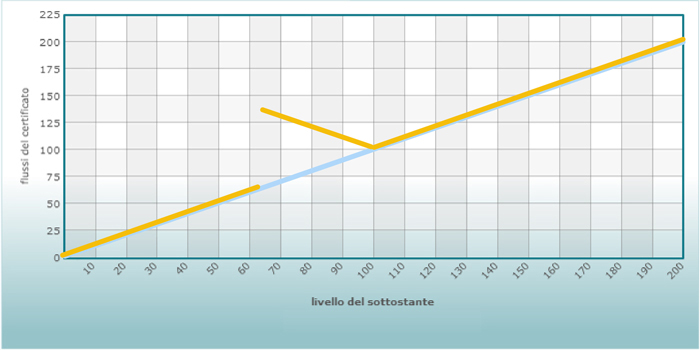
| Maturity | 3 - 4 years |
| Investment horizon | Mid / long term |
| Aim | To profit from both upward and small downward movements of the underlying asset’s price |
| Strategy | Bi-directional (at issue), if the underlying asset’s price does not reach the barrier during the life of the certificate Bullish, if the underlying asset’s price exceeds the barrier level during the life of the certificate |
| Capital protection at maturity/Risk | Capital protection at maturity up to a set level. Partial replication of downward movements of the underlying asset’s price in case the underlying asset’s price has been lower than or equal to the barrier level during the life of the certificate |
Learn more
Investment certificates are financial products characterized by a number of features. They may simply replicate the underlying asset’s upward movements or downward movements, or they may be structured so as to implement more sophisticated strategies, which may include total or conditional capital protection against bad performances of the underlying asset.
Some certificates’ characteristics may also allow the owners to obtain proceeds during the life of the certificate, under condition that specific events take place. A premium may be paid at maturity under form of additional proceeds in case the underlying asset’s price does not drop under the barrier (this is the case, for example, of bonus certificates).
The return on investment in some typologies of certificates may be determined by both the changes in the underlying asset’s price and the absence of such price movements for a timespan shorter than the life of the contract. These certificates pay a sort of premium for early redemption in case the underlying asset’s price is above a certain level on pre-arranged dates.
Moreover, some certificates feature an additional element, useful in periods of strong fluctuations of exchange rates – a protection against unfavourable changes in currency value. Products offering such protection, called “Quantum”, make it possible to invest in underlying asset’s denominated in a foreign currency avoiding exposure to the risks linked to exchange rates.
Features
The certificates’ payoff characteristics imply the following components: protection component, participation to upward movements in the underlying asset’s price, participation to downward movements in the underlying asset’s price.
Performance drivers
Reactivity of the certificates’ prices to changes in key variables.
| Variables | Issue | Barrier** | Life residual*** |
European barrier
Commercial names
Twin Win, Up&Up
Characteristics:
Full replication of upward and downward movements of the underlying asset’s price at maturity
Barrier for conditional capital protection (relevant only at maturity)
Full, more than proportional replication of upward movements of the underlying asset’s price
Return profiles
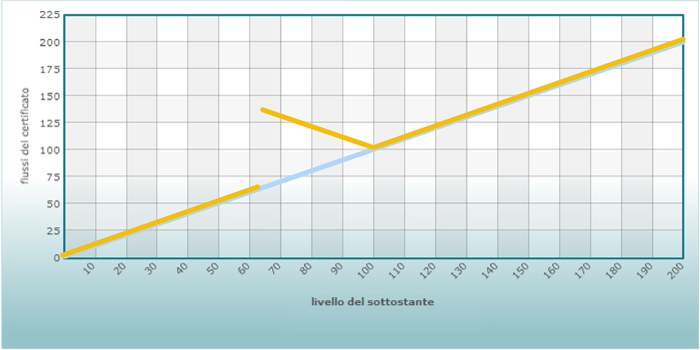
| Maturity | 3 - 5 years |
| Investment horizon | Mid / long term |
| Aim | To profit from both upward and small downward movements of the underlying asset’s price |
| Strategy | Bi-direzional |
| Capital protection at maturity/Risk | Capital protection at maturity up to a set level. Partial replication of downward movements of the underlying asset’s price in case the underlying asset’s price is lower than or equal to the barrier level at maturity |
Learn more
Investment certificates are financial products characterized by a number of features. They may simply replicate the underlying asset’s upward movements or downward movements, or they may be structured so as to implement more sophisticated strategies, which may include total or conditional capital protection against bad performances of the underlying asset (protection component).
Some certificates’ characteristics may also allow the owners to obtain proceeds during the life of the certificate, under condition that specific events take place (income component). A premium may be paid at maturity under form of additional proceeds in case the underlying asset’s price does not drop under the barrier (this is the case, for example, of bonus certificates).
The return on investment in some typologies of certificates may be determined by both the changes in the underlying asset’s price and the absence of such price movements for a timespan shorter than the life of the contract (early reimbursement component). These certificates pay a sort of premium for early redemption in case the underlying asset’s price is above a certain level on pre-arranged dates.
Moreover, some certificates feature an additional element, useful in periods of strong fluctuations of exchange rates – a protection against unfavourable changes in currency value. Products offering such protection, called “Quantum”, make it possible to invest in underlying asset’s denominated in a foreign currency avoiding exposure to the risks linked to exchange rates.
Features
The certificates’ payoff characteristics imply the following components: protection component, participation to upward movements in the underlying asset’s price, participation to downward movements in the underlying asset’s price
Performance drivers
Reactivity of the certificates’ prices to changes in key variables.
| Variables | Issue | Barrier** | Life residual*** |
Worst Of
Commercial names
Twin Win, Up&Up
Caracteristics:
Underlying asset consisting in a basket of securities and indexes among which the worst performing determines the overall performance of the certificate
Barrier for conditional capital protection
Full, more than proportional replication of upward movements of the underlying asset’s price
Full replication of upward and downward movements of the underlying asset’s price at maturity
Return investment
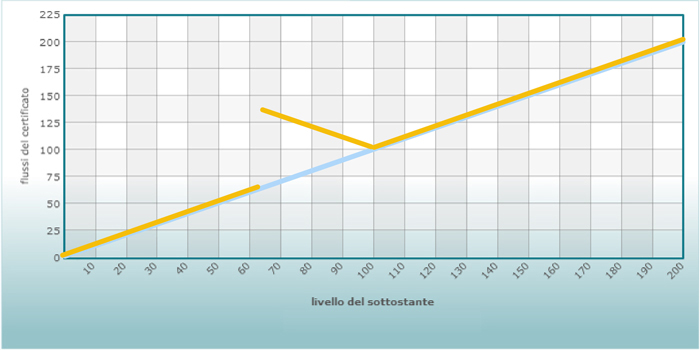
| Maturity | 3 - 5 years |
| Investment horizon | Mid / long term |
| Aim | To profit from both upward and small downward movements of the underlying asset’s price |
| Strategy | Bi-directional (at issue), if the underlying asset’s price does not reach the barrier during the life of the certificate Bullish, if the underlying asset’s price exceeds the barrier level during the life of the certificate |
| Capital protection at maturity/Risk | Capital protection at maturity (if the barrier is not reached). Full replication of downward movements of the underlying asset’s price in case the price of the worst performing security part the underlying asset has been lower than or equal to the barrier level during the life of the certificate |
Learn more
Investment certificates are financial products characterized by a number of features. They may simply replicate the underlying asset’s upward movements or downward movements, or they may be structured so as to implement more sophisticated strategies, which may include total or conditional capital protection against bad performances of the underlying asset (protection component).
Some certificates’ characteristics may also allow the owners to obtain proceeds during the life of the certificate, under condition that specific events take place (income component). A premium may be paid at maturity under form of additional proceeds in case the underlying asset’s price does not drop under the barrier (this is the case, for example, of bonus certificates).
The return on investment in some typologies of certificates may be determined by both the changes in the underlying asset’s price and the absence of such price movements for a timespan shorter than the life of the contract (early reimbursement component). These certificates pay a sort of premium for early redemption in case the underlying asset’s price is above a certain level on pre-arranged dates.
Moreover, some certificates feature an additional element, useful in periods of strong fluctuations of exchange rates – a protection against unfavourable changes in currency value. Products offering such protection, called “Quantum”, make it possible to invest in underlying asset’s denominated in a foreign currency avoiding exposure to the risks linked to exchange rates.
Features
The certificates’ payoff characteristics imply the following components: protection component, participation to upward movements in the underlying asset’s price, participation to downward movements in the underlying asset’s price.
Performance drivers
Reactivity of the certificates’ prices to changes in key variables.
| Variables | Issue | Barrier** | Life residual*** |
Rainbow
Commercial names
Twin Win
Caracteristics:
Underlying asset consisting in a basket of securities present in proportions determined by their performances
Full replication of upward and downward movements of the underlying asset’s price at maturity
Full, more than proportional replication of upward movements of the underlying asset’s price
Barrier for conditional capital protection
Return profile
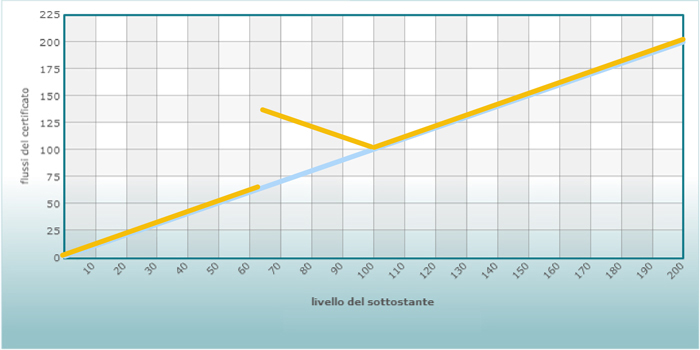
| Maturity | 3 - 5 years |
| Investment horizon | Mid / long term |
| Aim | To profit from both upward and small downward movements of the underlying asset’s price |
| Strategy | Bi-directional (at issue), if the underlying asset’s price does not reach the barrier during the life of the certificate Bullish, if the underlying asset’s price exceeds the barrier level during the life of the certificate |
| Capital protection at maturity/Risk | Capital protection at maturity up to a set level. Partial replication of downward movements of the underlying asset’s price in case the underlying asset’s price has been lower than or equal to the barrier level during the life of the certificate |
Learn more
Investment certificates are financial products characterized by a number of features. They may simply replicate the underlying asset’s upward movements or downward movements, or they may be structured so as to implement more sophisticated strategies, which may include total or conditional capital protection against bad performances of the underlying asset (protection component).
Some certificates’ characteristics may also allow the owners to obtain proceeds during the life of the certificate, under condition that specific events take place (income component). A premium may be paid at maturity under form of additional proceeds in case the underlying asset’s price does not drop under the barrier (this is the case, for example, of bonus certificates).
The return on investment in some typologies of certificates may be determined by both the changes in the underlying asset’s price and the absence of such price movements for a timespan shorter than the life of the contract (early reimbursement component). These certificates pay a sort of premium for early redemption in case the underlying asset’s price is above a certain level on pre-arranged dates.
Moreover, some certificates feature an additional element, useful in periods of strong fluctuations of exchange rates – a protection against unfavourable changes in currency value. Products offering such protection, called “Quantum”, make it possible to invest in underlying asset’s denominated in a foreign currency avoiding exposure to the risks linked to exchange rates.
Features
The certificates’ payoff characteristics imply the following components: protection component, participation to upward movements in the underlying asset’s price, participation to downward movements in the underlying asset’s price.
Performance drivers
Reactivity of the certificates’ prices to changes in key variables.
| Variables | Issue | Barrier** | Life residual*** |
Best Of
Commercial names
Twin Win
Caracteristics:
Underlying asset consisting in a basket of securities and indexes among which the best performing determines the overall performance of the certificate
Full, more than proportional replication of upward movements of the underlying asset’s price
Full replication of upward and downward movements of the underlying asset’s price at maturity
Barrier for conditional capital protection
Return profiles
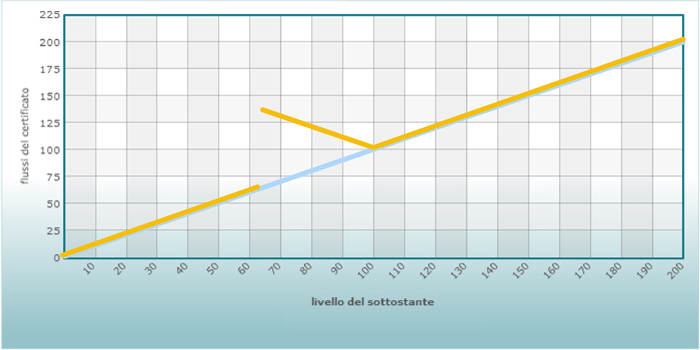
| Matutity | 3 - 5 anni |
| Investment horizon | Mid / long term |
| Aim | To profit from both upward and small downward movements of the underlying asset’s price |
| Strategy | Bi-directional (at issue), if the underlying asset’s price does not reach the barrier during the life of the certificate Bullish, if the underlying asset’s price exceeds the barrier level during the life of the certificate |
| Capital protection at maturity/Risk | Capital protection at maturity (if the barrier is not reached). Full replication of downward movements of the underlying asset’s price in case the price of the best performing security part the underlying asset has been lower than or equal to the barrier level during the life of the certificate |
Learn more
Investment certificates are financial products characterized by a number of features. They may simply replicate the underlying asset’s upward movements or downward movements, or they may be structured so as to implement more sophisticated strategies, which may include total or conditional capital protection against bad performances of the underlying asset (protection component).
Some certificates’ characteristics may also allow the owners to obtain proceeds during the life of the certificate, under condition that specific events take place (income component). A premium may be paid at maturity under form of additional proceeds in case the underlying asset’s price does not drop under the barrier (this is the case, for example, of bonus certificates).
The return on investment in some typologies of certificates may be determined by both the changes in the underlying asset’s price and the absence of such price movements for a timespan shorter than the life of the contract (early reimbursement component). These certificates pay a sort of premium for early redemption in case the underlying asset’s price is above a certain level on pre-arranged dates.
Moreover, some certificates feature an additional element, useful in periods of strong fluctuations of exchange rates – a protection against unfavourable changes in currency value. Products offering such protection, called “Quantum”, make it possible to invest in underlying asset’s denominated in a foreign currency avoiding exposure to the risks linked to exchange rates.
Features
The certificates’ payoff characteristics imply the following components: protection component, participation to upward movements in the underlying asset’s price, participation to downward movements in the underlying asset’s price.
Performance drivers
Reactivity of the certificates’ prices to changes in key variables.
| Variables | Issue | Barrier** | Life residual*** |
Cap
Commercial names
Twin Win Cap
Caracteristics:
Full replication of upward and downward movements of the underlying asset’s price at maturity
Barrier for conditional capital protection
Cap on potential returns
Full, more than proportional replication of upward movements of the underlying asset’s price
Return profiles
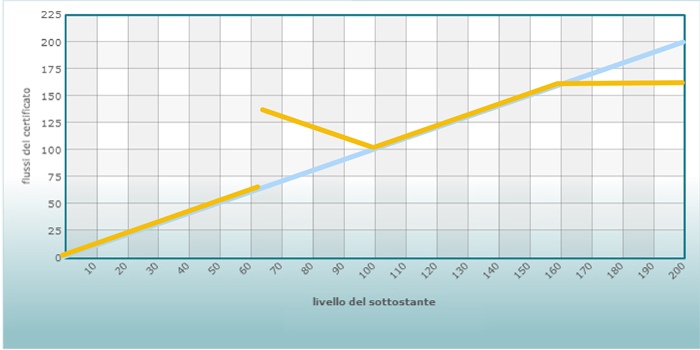
| Maturity | 3 - 4 years |
| Investment horizon | Mid term |
| Aim | To profit from both upward and small downward movements of the underlying asset’s price |
| Strategy | Bi-directional (at issue), if the underlying asset’s price does not reach the barrier during the life of the certificate Bullish, if the underlying asset’s price exceeds the barrier level during the life of the certificate |
| Capital protection at maturity/Risk | Capital protection at maturity up to a set level. Partial replication of downward movements of the underlying asset’s price in case the underlying asset’s price has been lower than or equal to the barrier level during the life of the certificate |
Learn more
Investment certificates are financial products characterized by a number of features. They may simply replicate the underlying asset’s upward movements or downward movements, or they may be structured so as to implement more sophisticated strategies, which may include total or conditional capital protection against bad performances of the underlying asset.
Some certificates’ characteristics may also allow the owners to obtain proceeds during the life of the certificate, under condition that specific events take place. A premium may be paid at maturity under form of additional proceeds in case the underlying asset’s price does not drop under the barrier (this is the case, for example, of bonus certificates).
The return on investment in some typologies of certificates may be determined by both the changes in the underlying asset’s price and the absence of such price movements for a timespan shorter than the life of the contract. These certificates pay a sort of premium for early redemption in case the underlying asset’s price is above a certain level on pre-arranged dates.
Moreover, some certificates feature an additional element, useful in periods of strong fluctuations of exchange rates – a protection against unfavourable changes in currency value. Products offering such protection, called “Quantum”, make it possible to invest in underlying asset’s denominated in a foreign currency avoiding exposure to the risks linked to exchange rates.
Features
The certificates’ payoff characteristics imply the following components: protection component, participation to upward movements in the underlying asset’s price, participation to downward movements in the underlying asset’s price.
Performance drivers
Reactivity of the certificates’ prices to changes in key variables.
| Variables | Issue | Barrier** | Life residual*** |
Short
Commercial names
Twin Win Short, Twin Win Protection Short
Caracteristics:
Full replication of downward movements of the underlying asset’s price
Barrier for conditional capital protection
Replication of upward movements of the underlying asset’s price up to the barrier level
Return profiles
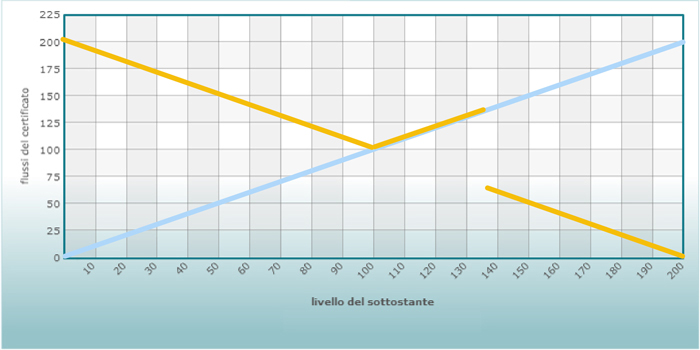
| Maturity | 3 - 5 years |
| Investment horizon | Mid / long term |
| Aim | To profit from both upward and small downward movements of the underlying asset’s price |
| Strategy | Bi-directional (at issue), if the underlying asset’s price does not reach the barrier during the life of the certificate Bearish, if the underlying asset’s price reaches the barrier level during the life of the certificate |
| Capital protection at maturity/Risk | Capital protection at maturity up to a set level. Full replication of upward movements of the underlying asset’s price in case the underlying asset’s price has been higher than or equal to the barrier level during the life of the certificate |
Learn more
Investment certificates are financial products characterized by a number of features. They may simply replicate the underlying asset’s upward movements or downward movements, or they may be structured so as to implement more sophisticated strategies, which may include total or conditional capital protection against bad performances of the underlying asset (protection component).
Some certificates’ characteristics may also allow the owners to obtain proceeds during the life of the certificate, under condition that specific events take place (income component). A premium may be paid at maturity under form of additional proceeds in case the underlying asset’s price does not drop under the barrier (this is the case, for example, of bonus certificates).
The return on investment in some typologies of certificates may be determined by both the changes in the underlying asset’s price and the absence of such price movements for a timespan shorter than the life of the contract (early reimbursement component). These certificates pay a sort of premium for early redemption in case the underlying asset’s price is above a certain level on pre-arranged dates.
Moreover, some certificates feature an additional element, useful in periods of strong fluctuations of exchange rates – a protection against unfavourable changes in currency value. Products offering such protection, called “Quantum”, make it possible to invest in underlying asset’s denominated in a foreign currency avoiding exposure to the risks linked to exchange rates.
Features
The certificates’ payoff characteristics imply the following components: protection component, participation to upward movements in the underlying asset’s price, participation to downward movements in the underlying asset’s price.
Performance drivers
Reactivity of the certificates’ prices to changes in key variables.
| Variables | Issue | Barrier** | Life residual*** |
Protection
Commercial names
CP90 Twin Win, Twin Win Protection
Caracteristics:
Full replication of upward and downward movements of the underlying asset’s price at maturity
Full or partial protection of nominal invested capital
Full, more than proportional replication of upward movements of the underlying asset’s price
Return investment
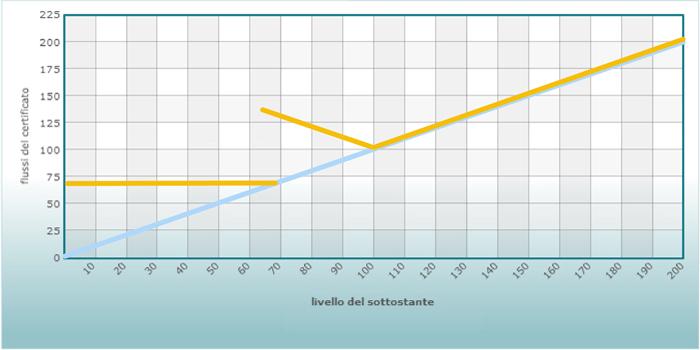
| Maturity | 3 - 5 years |
| Investment horizon | mid /long term |
| Aim | To profit from both upward and small downward movements of the underlying asset’s price |
| Strategy | Bi-directional (at issue), if the underlying asset’s price does not reach the barrier during the life of the certificate Bullish, if the underlying asset’s price exceeds the barrier level during the life of the certificate |
| Capital protection at maturity/Risk | Full or partial capital protection at maturity in case of drop of the underlying asset’s price |
Learn more
Investment certificates are financial products characterized by a number of features. They may simply replicate the underlying asset’s upward movements or downward movements, or they may be structured so as to implement more sophisticated strategies, which may include total or conditional capital protection against bad performances of the underlying asset (protection component).
Some certificates’ characteristics may also allow the owners to obtain proceeds during the life of the certificate, under condition that specific events take place (income component). A premium may be paid at maturity under form of additional proceeds in case the underlying asset’s price does not drop under the barrier (this is the case, for example, of bonus certificates).
The return on investment in some typologies of certificates may be determined by both the changes in the underlying asset’s price and the absence of such price movements for a timespan shorter than the life of the contract (early reimbursement component). These certificates pay a sort of premium for early redemption in case the underlying asset’s price is above a certain level on pre-arranged dates.
Moreover, some certificates feature an additional element, useful in periods of strong fluctuations of exchange rates – a protection against unfavourable changes in currency value. Products offering such protection, called “Quantum”, make it possible to invest in underlying asset’s denominated in a foreign currency avoiding exposure to the risks linked to exchange rates.
Features
The certificates’ payoff characteristics imply the following components: protection component, participation to upward movements in the underlying asset’s price, participation to downward movements in the underlying asset’s price.
Performance drivers
Reactivity of the certificates’ prices to changes in key variables.
| Variables | Issue | Barrier** | Life residual*** |
